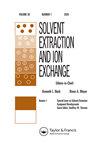酸性矿山废水中瞬态金属离子的选择性去除及电解回收金属铜的可能性
IF 2.1
4区 化学
Q3 CHEMISTRY, MULTIDISCIPLINARY
引用次数: 1
摘要
酸性矿井排水(AMD)的低pH值和高盐度从根本上使吸附过程复杂化。我们探索了使用螯合树脂Lewatit®MonoPlus TP 220和Lewatit™TP 208从过量的亚铁离子中选择性去除AMD中存在的Cu、Ni和Co离子。此外,还研究了利用电解从解吸溶液中回收金属铜的方法。结果表明,螯合吸附剂Lewatit®TP 220实现了对金属离子的最有效吸附。吸附剂在给定条件下的动态容量(pH= 2.5 ± 0.03,Fe(II/III)、Zn(II)、Mn(II)的存在按以下顺序减少:Cu(II)(43.3 ± 1.4 g/L)>Ni(II)(22.1 ± 2.1 g/L)>Co(II)(3.6 ± 0.4 g/L)。在相同条件下螯合树脂Lewatit®TP 208显示出较低的效率:Cu(II)(30.6 ± 1.3 g/L)>Ni(II)(9.1 ± 0.17 g/L)>Co(II)(1.3 ± 0.08 g/L)。弱碱阴离子交换剂Purolite®A832成功地用于从氨溶液中吸收Cu(II),并易于用硫酸再生。计算出Cu(II)的吸附容量为19.2 ± 0.5 g/L。用流化床电解反应器进行电解实验,其中从解吸溶液中再生金属铜并获得纯化的硫酸溶液。图形摘要本文章由计算机程序翻译,如有差异,请以英文原文为准。
Selective Removal of Transient Metal Ions from Acid Mine Drainage and the Possibility of Metallic Copper Recovery with Electrolysis
ABSTRACT The low pH and high salinity of acid mine drainage (AMD) fundamentally complicates the sorption processes. We explored the selective removal of Cu, Ni and Co ions present in AMD from the excess of ferrous ions of using a chelating resins Lewatit® MonoPlus TP 220 and Lewatit® TP 208. Also, the recovery of metal copper from desorption solution using electrolysis was investigated. The results showed that the most effective sorption of metal ions was achieved with chelating sorbent Lewatit® TP 220. The dynamic capacity of the sorbent under the given conditions (pH= 2.5 ± 0.03, presence of Fe(II/III), Zn(II), Mn(II)) decreased in the following order: Cu(II) (43.3 ± 1.4 g/L) > Ni(II) (22.1 ± 2.1 g/L) > Co(II) (3.6 ± 0.4 g/L). Chelating resin Lewatit® TP 208 under the same conditions showed lower efficiency: Cu(II) (30.6 ± 1.3 g/L) > Ni(II) (9.1 ± 0.17 g/L) > Co(II) (1.3 ± 0.08 g/L). The weak base anion exchanger Purolite® A 832 was successfully used to take up Cu(II) from ammonia solution and easily regenerated with sulfuric acid. The sorption capacity for Cu(II) was calculated to be 19.2 ± 0.5 g/L. Electrolysis experiments were performed with a fluidized bed electrolysis reactor where metallic copper was regenerated from desorption solutions and purified sulfuric acid solutions were obtained. GRAPHICAL ABSTRACT
求助全文
通过发布文献求助,成功后即可免费获取论文全文。
去求助
来源期刊
CiteScore
4.40
自引率
5.00%
发文量
15
审稿时长
8.4 months
期刊介绍:
Solvent Extraction and Ion Exchange is an international journal that publishes original research papers, reviews, and notes that address all aspects of solvent extraction, ion exchange, and closely related methods involving, for example, liquid membranes, extraction chromatography, supercritical fluids, ionic liquids, microfluidics, and adsorption. We welcome submissions that look at: The underlying principles in solvent extraction and ion exchange; Solvent extraction and ion exchange process development; New materials or reagents, their syntheses and properties; Computational methods of molecular design and simulation; Advances in equipment, fluid dynamics, and engineering; Interfacial phenomena, kinetics, and coalescence; Spectroscopic and diffraction analysis of structure and dynamics; Host-guest chemistry, ion receptors, and molecular recognition.

 求助内容:
求助内容: 应助结果提醒方式:
应助结果提醒方式:


